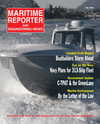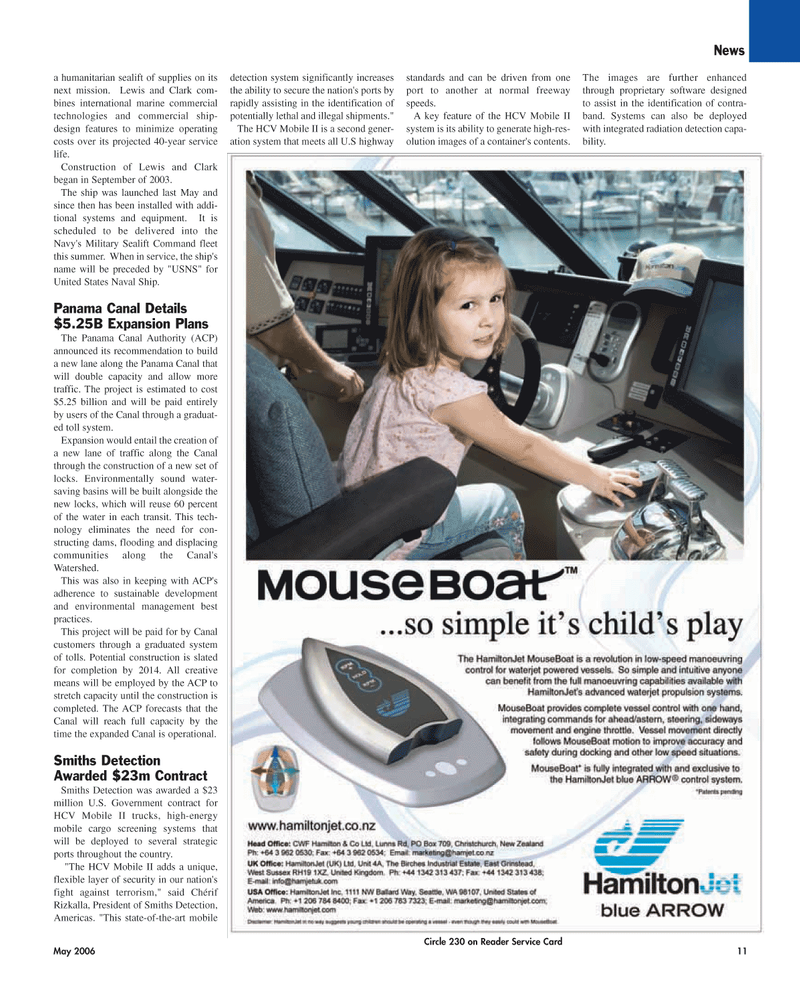
Page 11: of Maritime Reporter Magazine (May 2006)
The Marine Enviroment
Read this page in Pdf, Flash or Html5 edition of May 2006 Maritime Reporter Magazine
May 2006 11 a humanitarian sealift of supplies on its next mission. Lewis and Clark com- bines international marine commercial technologies and commercial ship- design features to minimize operating costs over its projected 40-year service life.
Construction of Lewis and Clark began in September of 2003.
The ship was launched last May and since then has been installed with addi- tional systems and equipment. It is scheduled to be delivered into the
Navy's Military Sealift Command fleet this summer. When in service, the ship's name will be preceded by "USNS" for
United States Naval Ship.
Panama Canal Details $5.25B Expansion Plans
The Panama Canal Authority (ACP) announced its recommendation to build a new lane along the Panama Canal that will double capacity and allow more traffic. The project is estimated to cost $5.25 billion and will be paid entirely by users of the Canal through a graduat- ed toll system.
Expansion would entail the creation of a new lane of traffic along the Canal through the construction of a new set of locks. Environmentally sound water- saving basins will be built alongside the new locks, which will reuse 60 percent of the water in each transit. This tech- nology eliminates the need for con- structing dams, flooding and displacing communities along the Canal's
Watershed.
This was also in keeping with ACP's adherence to sustainable development and environmental management best practices.
This project will be paid for by Canal customers through a graduated system of tolls. Potential construction is slated for completion by 2014. All creative means will be employed by the ACP to stretch capacity until the construction is completed. The ACP forecasts that the
Canal will reach full capacity by the time the expanded Canal is operational.
Smiths Detection
Awarded $23m Contract
Smiths Detection was awarded a $23 million U.S. Government contract for
HCV Mobile II trucks, high-energy mobile cargo screening systems that will be deployed to several strategic ports throughout the country. "The HCV Mobile II adds a unique, flexible layer of security in our nation's fight against terrorism," said Chérif
Rizkalla, President of Smiths Detection,
Americas. "This state-of-the-art mobile detection system significantly increases the ability to secure the nation's ports by rapidly assisting in the identification of potentially lethal and illegal shipments."
The HCV Mobile II is a second gener- ation system that meets all U.S highway standards and can be driven from one port to another at normal freeway speeds.
A key feature of the HCV Mobile II system is its ability to generate high-res- olution images of a container's contents.
The images are further enhanced through proprietary software designed to assist in the identification of contra- band. Systems can also be deployed with integrated radiation detection capa- bility.
Circle 230 on Reader Service Card
News
MR MAY2006 #2 (9-16).qxd 5/8/2006 11:10 AM Page 11

 10
10

 12
12
